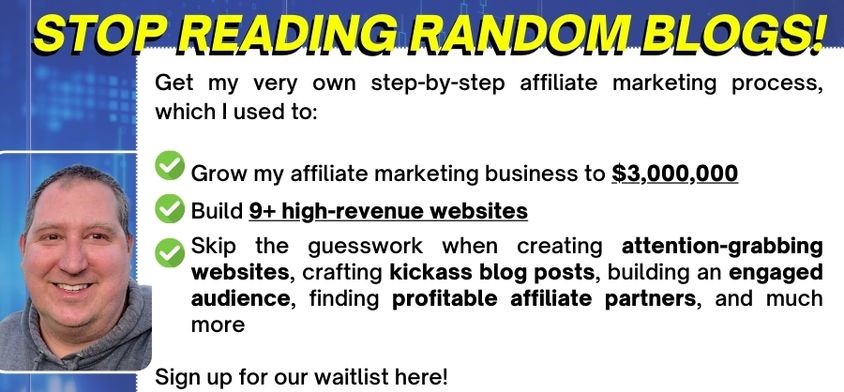Affiliate marketing is much more than just putting a few blog posts together and throwing in some affiliate links. It’s more than promoting products on your social media accounts, writing reviews of products, or sharing information about a new service. It requires a lot of work to truly become successful.
As you look up information about how to do affiliate marketing, you may become quite overwhelmed. After all, there is so much circulating out there, and a lot of it with overlapping tips. While every site is different, there are a few basic steps you can follow to ensure you’ve got the best strategy for your affiliate marketing site.
Figure Out Your Niche
Decide on a category of products and services that you’d like to be promoting and working with. Consider not only your expertise but also your interests—in fact, sometimes enthusiasts are the most passionate affiliate marketers. Click here and sign up for a FREE video series on choosing a profitable niche.
Investigate Your Audience
You’ll next want to know everything about your audience. When you have a thorough understanding of their likes, dislikes, habits, aspirations, job situation, and spending habits, you can create better content, promote it at the right times and on the right social networks, and you can predict their needs.When trying to figure out your ideal client, make sure you know:
- Your client’s age, gender, geographic location, education level, and income.
- What job they currently have and/or the job they hope to have.
- Their hobbies, favorite tv shows, movies, books, and music, as well as how they spend their free time.
- What types of things make them laugh.
- The types of products or services they happily splurge on.
- What they struggle with and what stresses them out on a regular basis.
- What scares them and what they try to avoid dealing with.
- What types of goals they are currently working towards in their life.
You’ll also want to figure out a few things directly related to your site, including:
- Why they are interested in reading the content on your site.
- How they would discover your website or blog.
- What would make them excited about sharing your website with others.
- How often they are on the internet each day.
Choose The Right Affiliate Programs
When applying to affiliate programs or networks, make sure you choose ones that suit your audience. You can refer to some of your notes from step two to help you figure out what will or won’t work.Make sure to consider:
- How you earn money. Is it pay per sale or pay per click?
- Your commission rate.
- The pay threshold.
- Website reviews. If the site has poor customer service, this could result in returns which means less money for you.
- Competition. Obviously a lesser-known affiliate program or network could mean you’re one of the prominent promoters of the products. It could also mean it’s harder to earn money.
- The terms and conditions. Always make sure to read the fine print.
Use Your Links In Various Ways
Of course, as you learn how to do affiliate marketing you might initially think that links are simply for blog posts, but you can actually use them in a wide variety of ways. Take into account what your ideal client is like from the information in step two to decide how best to reach them. This includes:
- Coupons. Coupons can offer your audience a percentage off or a certain amount off of a sale, and you can earn commission. Depending on what types of products and services you promote, this can be incredibly popular. These are perfect for visitors who are looking for a good deal and want a reliable product at a cheaper rate. Some people out there just can’t pass up a deal, and when they see they can get something for less—even if it’s just a small percentage off—they will be much more likely to buy.
- Product reviews. These are most effective when you are completely honest, providing both the pros and cons of each item. People know that the things they buy will never be perfect, so if you only ever rave about every product you review, they will likely not trust your opinion. Honest reviews, however, will generate more buzz and be much more likely to be shared.
- Social media. Promote products quickly and easily on your Twitter or post updates on your Facebook account. If you have a big following on social media, this can be an effective way to share the products and services you love.
- YouTube videos. You can do product reviews and include the affiliate links in the description, making sales off of anyone who views the video and is interested in what you’re selling. Alternatively, you can simply provide useful information to viewers and include related links in the description, such as the gear you used to film it.
- Banner ads. For those who visit your site, banner ads at the top, in the sidebar, or even in posts can generate clicks. If you’re able to use ads that suit the look of your site, it will boost the design aspect and make your brand look more cohesive.
- Blog posts. This is what people traditionally think of with affiliate links. You can write posts specifically about a product or simply sprinkle them into posts as it is appropriate. Minimize the amount of additional links to increase your chances of affiliate links getting attention, and make sure they stand out with a color different than the regular text hue.
Learn more ways to promote affiliate products here.
And remember that you don’t have to do just one of these methods, and that other ones not listed here are also fair game. In fact, you’re encouraged to diversify your income, so use a combination that suits you and your audience to maximize sales.


